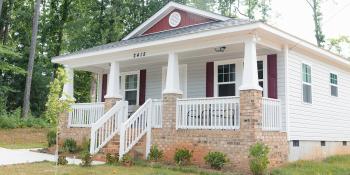HFH of the Lehigh Valley ReStore- Hellertown
Habitat houses: Recognizing best-in-class designs
From building resilient, hurricane-proof homes in Florida to prototyping with a 3D-printed home in Virginia, Habitat affiliates in the U.S. seek innovative solutions to local, pressing needs. The 2021 Habitat House Design Contest, generously sponsored for a second year by Simpson Strong-Tie, invited local affiliates to submit their home designs across a range of categories, including equity, multifamily, sustainability and many more.
Community development financial institutions
Learn about community development financial institutions and how they improve housing and livelihoods in underserved neighborhoods.
Without equitable access to affordable credit and investment capital, people living in low-income communities often face barriers to quality housing, education, health care, jobs and other essential services. Community development financial institutions, or CDFIs, can reduce those barriers by unlocking access to basic financial services for those traditionally excluded by mainstream financial systems.
In 2017 Habitat for Humanity International established Habitat Capital as our own CDFI. Together with local Habitat affiliates, some of which have decades of experience operating as or like CDFIs, we are increasing affordable homeownership through providing flexible capital, mortgage origination support and financial services. In this explainer, learn more about how CDFIs improve housing and livelihoods in underserved neighborhoods.
What are community development financial institutions?
CDFIs sprang onto the financial scene in 1977 following the passage of the Community Reinvestment Act, which encouraged financial institutions to serve low- and middle-income people who had been systemically excluded from equitable and basic financial services through practices like redlining. Further laws enacted by the U.S. Congress — namely the Riegle Act of 1994, which created the CDFI Fund — have reinforced the importance of CDFIs in American banking.
CDFIs are mission-driven financial institutions that serve low-income communities and residents across the U.S. who often lack access to financing. Where traditional banks might see risk when reviewing loan applications from low-income individuals, CDFIs see opportunity.
CDFIs partner with underserved businesses and individuals to spur growth at the community level, using a holistic and people-centered approach to inject much-needed capital and financial services into disinvested areas.
The collective impact of CDFIs nationwide has created millions of jobs, jump started businesses, increased affordable housing availability and expanded community facilities.
The four types of CDFIs
Though CDFIs share similar tenets, they operate in different ways. There are four types of CDFIs:
- Community development banks are federally insured for-profit institutions that operate much like a traditional bank, though they carry an imperative to direct a minimum of 60% of their financing to distressed communities.
- Community development credit unions are nonprofit, member-owned cooperatives that offer credit counseling, business planning and other basic financial services to low-income individuals often living in underprivileged communities.
- Community development loan funds provide financing and development services for microenterprises, small businesses, housing development and community service organizations. This is the most common type, representing more than half of all CDFIs.
- Community development venture capital funds pool money from investors to finance small businesses that improve community and economic development goals while also yielding financial returns. This is the least common type of CDFI, making up just 1% of all CDFIs.
Scalable impact: CDFIs at work
In 2020, 4.6 million clients were served by one of more than 1,000 CDFIs operating in the U.S., according to an annual impact survey conducted by the CDFI Fund. These community-based financial institutions are critically reaching the people who need capital the most. A survey of 269 CDFIs who are members of Opportunity Finance Network revealed that the clients they served in 2020 were:
- 84% low-income, low-wealth or historically disinvested individuals.
- 60% people of color.
- 50% women.
- 27% rural borrowers.
CDFIs, including those operated by Habitat, enable low-income individuals to access the basic financial services that can propel them out of poverty and into life-changing positions like homeownership and financial independence. They are mainstays for under-resourced communities and will continue to be a valuable investment, creating financial access for their neighborhoods and residents.

Community development financial institutions
What they are and why they matter

Habitat CEO Jonathan Reckford statement on legislation that will reduce home energy costs and support home repair programs
Habitat for Humanity partners with U.S. Department of Veterans Affairs to increase homeownership among veterans
Habitat and the CAPABLE model
As part of our innovative Aging in Place strategies, Habitat for Humanity implemented the CAPABLE model across five Habitat affiliates. This model is an evidence-based approach developed by researchers from Johns Hopkins University to help holistically address older adults’ needs.
Bridging the Gap guide
Habitat created the Bridging the Gap guide to help Habitat affiliates and our fellow housing organizations connect their home repair and home modification work with the health care sector for a holistic aging in place approach.
Volunteer resources
Nothing is more important for Habitat for Humanity than the welfare of the people we work with every day. These resources and policies help ensure the safety of our volunteers, our employees and those in the communities where we work.
Expert economist explores current economy's impact on housing costs
We explored how today’s economic landscape impacts affordable homeownership and what’s in store for the months ahead with Mark Zandi, chief economist of Moody’s Analytics, as part of our +You thought leadership series.
